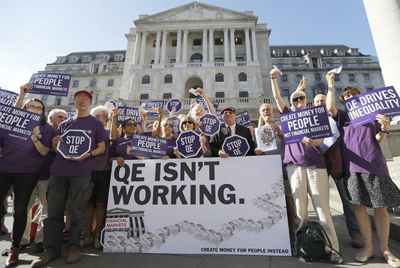The Destructive Force And Failure Of QE
Alasdair Mcleod
 This article concludes that quantitative easing as a means of stimulating economies and financing government deficits will fail. The underlying assumption is that the transmission of additional money to non-banks in order to inflate financial assets, and to banks to cover government finances, will become too great in 2021 for it to succeed without undermining fiat currencies and financial markets. Admittedly, this opinion stands in stark contrast to the common Keynesian view, that once covid is over economies will start to grow again. This article concludes that quantitative easing as a means of stimulating economies and financing government deficits will fail. The underlying assumption is that the transmission of additional money to non-banks in order to inflate financial assets, and to banks to cover government finances, will become too great in 2021 for it to succeed without undermining fiat currencies and financial markets. Admittedly, this opinion stands in stark contrast to the common Keynesian view, that once covid is over economies will start to grow again.
To help readers to understand why QE will fail, this article describes how its objectives have changed from stimulating the economy by raising asset prices, to financing rapidly increasing government budget deficits. It walks the reader through the inflationary differences between QE subscribed to by banks and by non-bank financial institutions, such as pension funds and insurance companies.
Having exhausted the reduction of interest rates as the principle means of economic stimulation, central banks, and especially the Fed, have embarked on pure monetary inflation. Before the end of 2019, that became the driving force behind the Fed’s monetary policy. Since March 2020 the objective behind QE altered again to financing the US government’s budget deficit.
In this current fiscal year, just to fund budget deficits and in the absence of net foreign demand for US Treasuries, QE is likely to escalate to a monthly average of $450bn. Almost impossible with a stable exchange rate, but with the dollar being sold down on foreign exchanges and for commodities, the everything dollar bubble will almost certainly collapse.
Introduction
Now that the US has elected a new president who will appoint a new administration, we must forget recent political events and focus on future economic and monetary policies. It is a statement of the obvious that President-elect Biden and his new Treasury Secretary will be naturally more Keynesian than Trump and Mnuchin, and it is likely that the economic focus will be more on stimulating consumption than on supply side economics. Policies are likely to be closer to modern monetary theory, which is highly inflationary — certainly much more so than under Trump’s presidency.
An important change is therefore bound to occur in monetary policy, and for the purpose of this debate we can forget any idea that the Fed, of for that matter any central bank, is an independent government agent prepared to restrict monetary growth responsibly. Beyond routine public expressions of independence, the Fed will fall in line with the Federal Government’s fiscal policies: it is up to the Fed to find a way to comply without losing face. However, in the early days of the new Biden administration this should not be too difficult because last March the Fed had already reduced the funds rate to the zero bound and announced unlimited quantitative easing, initially set at $120bn every month, as well as a range of other expansionary measures.
More QE is likely to be central to future monetary policies. But other than a bald assumption that QE is a sure-fire way to rescue an economy in difficulty, the consequences are poorly understood. In today’s context and other than the Japanese experiment with it which started long before, it was originally intended to be limited to the rescue of national economies following the Lehman banking crisis. But the precedent having been created it should be no surprise that it has become a permanent fixture for the Fed and other major central banks.
Doubtless, through linguistic prestigitation the term quantitative easing was meant to detract from public accusations of inflationary financing. If so, it succeeded. Public awareness of what is involved is apathetic in nature, and its monetary effects remain insufficiently understood. And the political class, not usually endowed with economic and monetary knowhow, sees little or no danger of the consequences of monetary inflation, having placed the matter entirely in their central banker’s hands.
The original objective is encapsulated in a few words in a Bank of England paper published in its 2014 Q1 Quarterly Bulletin, Money creation in the modern economy:
“QE is intended to boost the amount of money in the economy directly by purchasing assets, mainly from non-bank financial companies…. raising the prices of those assets and stimulating spending in the economy.”
The statement in this quote that stands out is about raising the prices of (financial) assets, being an admission of deliberately pursuing a John Law policy of printing money to rig market prices. Apologists for monetary policies might say that central banks have been manipulating asset prices for some considerable time, which is true. But a train of thought accelerating on the rails of a policy’s objectives towards the buffers at the end of the line always ends in disaster. All further considerations of the consequences are blanked out. The consequential impoverishment of everyone other than the state and its licenced banking intermediaries through monetary debasement does not deserve a mention.
The other processes of monetary creation described in the Quarterly Bulletin paper are certainly informative, and worth studying for those fuzzy on the subject. But while the article in the Quarterly Bulletin goes on to explain the intended outcome of QE at that time, things have clearly moved on and an update is due. In examining monetary flows from QE in detail, this article goes further than the Bank’s paper and does so from an independent standpoint.
Understanding the role of bank reserves
Under QE, monetary stimulation is channelled through commercial banks, ending up crediting their reserve accounts at the central bank. Understanding how these reserve accounts operate is important for a full understanding of QE’s mechanics, and can be boiled down to the following bullet points:
-
Only licenced commercial banks are permitted to have an account with the central bank. Any interaction between a central bank with a non-bank is conducted through a commercial bank’s reserve account.
-
The balance on a reserve account is recorded as an asset on the commercial bank’s balance sheet and is therefore one of several line items under its asset column.
-
Just as in any banking relationship, there are active and passive roles. In this case, only the central bank can activate changes in total reserves. A bank cannot initiate a sale or purchase of reserve funds to or from the central bank.
-
If a central bank lends money to a commercial bank, it is credited to its reserve account. This is not widely appreciated, but it undermines statistical analysis.
-
A bank can exchange its reserves with another bank with a reserve account at the central bank.
-
Being an asset on a commercial bank’s balance sheet, reserves held on its account with a central bank are an active source of finance for its liabilities.
From the foregoing, it will be clear that reserves are just one of a commercial bank’s means of funding its liabilities. Broadly, those liabilities are comprised of chequing and deposit accounts due to customers, bonds and bills issued by the bank, wholesale market funding, and shareholders’ funds. An increase in reserves permits a commercial bank to increase its liabilities by expanding bank credit. But the degree to which this is possible is governed by the gearing relationship between total assets and shareholders’ funds, which is a separate matter.
Stimulating the financial sector
The Bank of England’s paper posits that once interest rates reach the lower bound, the central bank cannot stimulate the economy any further by cutting interest paid on commercial banks’ reserves. It is at that point that asset purchases are considered as the means of getting more money into the economy, and as the authors put it, it requires a shift of policy from interest rate management to directly expanding the quantity of money. The original intention was to access non-bank financial institutions such as pension and insurance funds, buying government debt from them and encouraging them to reinvest the cash gained in higher yielding assets: in other words, to adopt greater investment risk, reflected in higher yields on non-government debt and from prospective returns in equities.
QE has certainly worked in this respect by feeding cash through these institutions into financial markets, driving prices ever higher. QE aimed at large investment funds is the link between accelerating rates of monetary inflation and the equity market bubble, a point missed by those who believe that financial markets must be grounded on assessments of fundamentals and risk. But the central bank view is that rising prices for financial assets floats all boats, and the wealth effect stimulates both confidence and economic activity. But it is a mistake to think that all QE ends up in pension and insurance funds. Increasingly, it has become a means of financing government deficits with commercial banks acting as principals in QE transactions, rather than just puffing up financial assets. And the delineation between banks and non-banks is important, because the monetary and market consequences are different.
How QE for non-banks works
The Bank of England’s paper makes a distinction of QE transactions taken up by non-bank financial institutions for good reasons. It has little to do directly with funding of a government deficit, which it was assumed at the time the paper was published would be through normal channels. Furthermore, the inflationary effects of QE targeted at non-banks, such as pension funds and insurance companies, is entirely different from that when a commercial bank subscribes for government debt.
In order for a central bank to deliver monetary stimulus to non-banks it must do so through a commercial bank, because only commercial banks have accounts with the central bank. The chain of payments is for the central bank to credit the reserve account of the fund’s bank, against which the bank credits the fund’s account with a matching entry. In the case of the Fed, the financial asset being bought, usually Treasury or agency bonds, is delivered out of the fund’s name and reregistered to the Fed’s account. The schematic diagram below, taken from the Bank of England’s article, summarises the transaction.

Alasdair became a stockbroker in 1970 and a Member of the London Stock Exchange in 1974. His experience encompasses equity and bond markets, fund management, corporate finance and investment strategy. After 27 years in the City, Alasdair moved to Guernsey. He worked as a consultant at many offshore institutions and was an Executive Director at an offshore bank in Guernsey and Jersey.
www.goldmoney.com
| 



